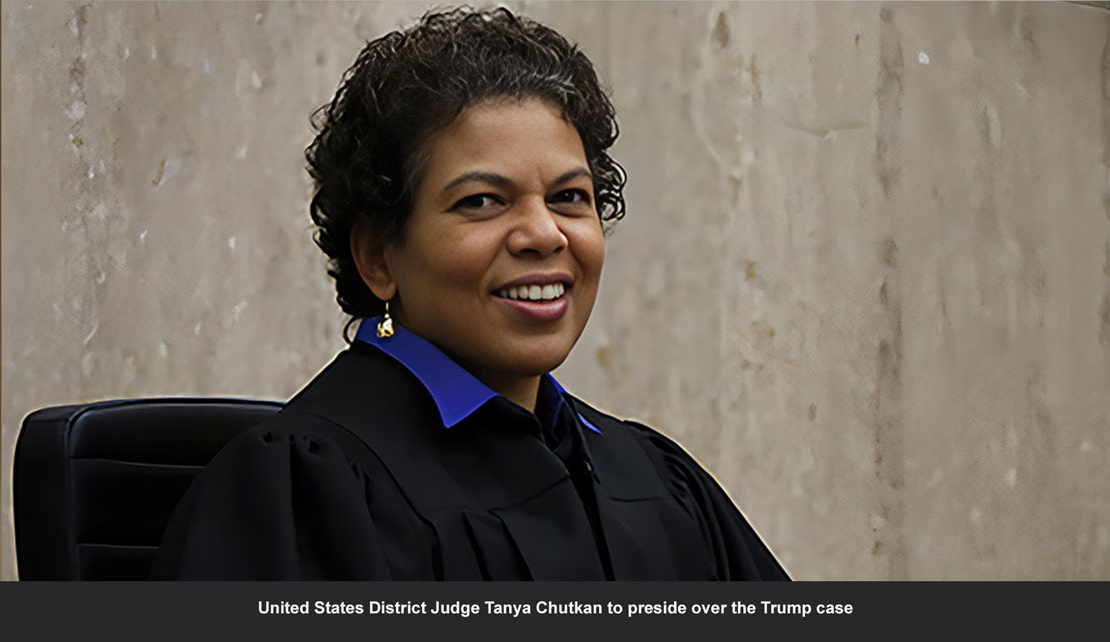By NAN Staff Writer
News Americas, NEW YORK, NY, Fri. Aug. 4, 2023: Much has been written about the judge who will preside over the federal case against former President Donald Trump. But here are 6 fast facts you should know:
1: Her background
Judge Tanya Chutkanwas born in Kingston, Jamaica on July 5, 1962, to Noelle Hill, the daughter of Frank Hill, one of the founding fathers of the People’s National Party, and Winston Chutkan, an Indo-Jamaican doctor, who graduated from the University of The West Indies, Trinidad in 1961.
Her mother was one of the leading dancers at the National Dance Theatre Company of Jamaica and her father specializes in orthopedic surgery. Her aunt is the mother of former Liverpool and England footballer, John Barnes.

2: Her education
Judge Chutkan migrated to the US and received her B.A. in Economics from George Washington University and her J.D. from the University of Pennsylvania Law School. She was also an Associate Editor of the Law Review and a Legal Writing Fellow. She graduated in 1987 with a Juris Doctor.
3: Her career
After law school, she worked in private practice for three years, then joined the District of Columbia Public Defender Service (“PDS”), where she worked as a trial attorney and supervisor. During her tenure at PDS, she argued several appellate cases and tried over 30 cases, including numerous serious felony matters. Eleven years later, she left PDS to join Boies, Schiller, & Flexner LLP, where she specialized in litigation and white-collar criminal defense. During her 12 years at the firm, her clients included antitrust class action plaintiffs, as well as individual and corporate defendants involved in complex state and federal litigation.
From 1996 – 2000 Judge Chutkan was a member of the Steering Committee for the Criminal Law and Individual Rights Section of the District of Columbia Bar. She is a frequent lecturer on trial techniques, and she has served as a faculty member at the Harvard Law School Trial Advocacy Workshop.
4: Her appointment:
Judge Chutkan was appointed to the United States District Court for the District of Columbia in June 2014 by former President Barack Obama.
5: Her rulings
She has already dealt Trumpeto one of the most significant legal blows of his lifetime, triggering perhaps the greatest deluge of evidence about his bid to subvert the 2020 election – a scheme for which he now stands charged with serious crimes.
It was Judge Chutkan who ruled in fall 2021 that the House Jan. 6th select committee could access reams of Trump’s White House files – a ruling that was subsequently upheld by an appeals court and left undisturbed by the Supreme Court.
She has also delivered some of the harshest sentences to Jan. 6 defendants and made her disgust and horror over the attack clear, lamenting the prospect of renewed political violence in 2024, and noting that no one accused of orchestrating the effort to subvert the election had been held accountable.
“You have made a very good point,” she told Jan. 6 rioter Robert Palmer at his December 2021 sentencing, “that the people who exhorted you and encouraged you and rallied you to go and take action and to fight have not been charged.”
6: Tid Bits
Judge Chutkan is 61 and is married to Peter Arno Krauthamer, 65, a former associate judge of the Superior Court of the District of Columbia. They have two sons. Judge Chutkan was randomly selected to preside over Trump’s latest criminal case, his third in the last four months.
CAHM 2023 – How Many Caribbean Immigrants Are In The United States?
By NAN Staff Writer
News Americas, NEW YORK, NY, Thurs. June 1, 2023: Happy National Caribbean American Heritage Month. Did you know that there are an estimated 4.8 million people from the Caribbean residing in the US? The Caribbean diaspora in the United States is, however, comprised of more than 8.5 million individuals who were either born in the Caribbean or reported ancestry of a given country in the Caribbean, according to tabulations from the U.S. Census Bureau’s 2019 ACS.
While exact numbers are challenging to determine, recent analysis of US Census data by News Americas sheds light on the Caribbean community’s presence in America.
Cuba takes the lead with an estimated 1.278 million individuals, followed closely by the Dominican Republic with 1.255 million. Jamaicans make up the third-largest group with 796,290 people, while Haitians are the fourth largest with 698,982.
Here’s a breakdown of other major countries represented in the Caribbean Diaspora:
Guyana: 289,870
Trinidad and Tobago: 219,683
Belize: 51,570
Barbados: 45,754
Bahamas: 34,069
Grenada: 31,871
Dominica: 30,395
St. Vincent and the Grenadines: 24,730
Additionally, smaller Caribbean nations were grouped as “other Caribbean” with a total count of 88,624. Another subset labeled as “West Indies” accounted for 15,878 individuals.
Caribbean immigrant journalist, entrepreneur, and advocate, Felicia J. Persaud, who championed the CARIB ID initiative to ensure Caribbean nationals got the chance to accurately represent their ancestry on US forms as of 2020, anticipates a significant increase in these numbers when the Census 2020 data on ancestry is compiled and released.
“Caribbean people have been an integral part of the US since slavery, yet as a bloc, they are often dismissed and overlooked due to limited economic data,” said Persaud, who also owns News Americas. “As we commemorate the 17th National Caribbean American Heritage Month, let’s celebrate and embrace the vibrant socio-economic contributions that Caribbean immigrants and those of Caribbean heritage make to the United States every single day!”
CAHM 2023 – Where Are Caribbean Immigrants Largely Located In The United States?
By NAN Staff Writer
News Americas, NEW YORK, NY, Fri. June 2, 2023: According to US Census data as of the 2015-19 period and the Migration Policy Center, two-thirds of immigrants from the Caribbean lived in just two states: Florida and New York.
Florida now accounts for the state with the most Caribbean immigrants at 41 percent. Miami-Dade County in Florida was home to 845,200 Caribbean immigrants, the highest share among all U.S. counties, representing 20 percent of the total Caribbean foreign-born population. Much smaller numbers or 282,800, reside in Broward County in Florida.
Palm Beach County in Florida accounted for the 6th largest estimated population of Caribbean immigrants in the US – at 146,400. Another 143,000 call the Orlando-Kissimmee-Sandford areas, also in Florida home while another 115,000 call the Tampa-St. Petersburg-Clearwater areas, also in Florida, home. Another 43,000 are in the Cape Coral-Fort Myers areas.
New York accounted for 25 percent of Caribbean immigrants. Most or an estimated 277,300 live in Brooklyn or Kings County while 274,700 live in the Bronx. Another 182,200 live in Queens. Manhattan, NY accounts for around 125,900.
The third largest state with Caribbean immigrants is Massachusetts with an estimated 165,000 living in the Boston-Cambridge-Newton areas while the fourth largest at an estimated 85,000 live in the Atlanta-Sandy Spring-Alpharetta, Georgia area.
The states of Philadelphia, New Jersey, Delaware and Maryland combined accounted for the fifth largest bloc of Caribbean immigrants nationally, at an estimated 80,000 while the states of Washington, D.C., Virginia and West Virginia accounted for 66,000, or the sixth largest bloc.
The seventh largest bloc according to limited Census data is in Houston, Woodlands and Sugarland, Texas, and is put at 57,000.
These figures offer valuable insights into the distribution of Caribbean immigrant communities across the United States as the rich cultural contributions and diverse experiences of Caribbean individuals continue to shape the fabric of American society.
.
CAHM 2023 – The Socio-Economic Profile Of Caribbean Immigrants In The United States
By NAN Staff Writer
News Americas, NEW YORK, NY, Weds. June 7, 2023: Caribbean immigrants generally have a higher median age compared to both the foreign-born and U.S.-born populations according to the 2019 Census Data analyzed and the Migration Policy Center.
In 2019, the median age of Caribbean immigrants was approximately 50, while it was 46 for the overall foreign-born population and 37 for the U.S.-born population.
A significant majority (73%) of Caribbean immigrants were of working age (18 to 64 years old), which was slightly lower than the overall immigrant population (78%) but higher than the native-born population (59%).
Among specific Caribbean groups, a substantial proportion of immigrants from the Dominican Republic (77%), Haiti (76%), Trinidad and Tobago, and Jamaica (75% each) were of working age, whereas around 28% of Cuban immigrants were seniors (ages 65 and older).
EDUCATION
Regarding educational attainment, Caribbean immigrant adults (ages 25 and older) were more likely to have graduated from high school compared to the overall foreign-born population. In comparison, 26% of all immigrants and 8% of U.S.-born adults did not complete high school.
Approximately 22% of Caribbean immigrants held a bachelor’s degree or higher. Notably, immigrants from Trinidad and Tobago (28%) and Jamaica (27%) had relatively higher rates of bachelor’s degree attainment, while around 31% of immigrants from the Dominican Republic did not graduate from high school.
In terms of higher education, around 11,200 Caribbean students were enrolled in U.S. higher educational institutions during the 2020-21 school year, comprising approximately 1% of all international students in the United States. Jamaica (2,700), the Bahamas (2,300), and the Dominican Republic (1,200) were the top origin countries for Caribbean international students.
WORK FORCE
Caribbean immigrants exhibit a similar labor force participation rate as the overall foreign-born population and a higher rate than the U.S. born. In 2019, approximately 67% of Caribbean immigrants and the overall immigrant population aged 16 and over were part of the civilian labor force, compared to 62% of the U.S. born.
When it comes to employment sectors, Caribbean immigrants are more likely to be engaged in service occupations and production, transportation, and material moving occupations compared to the other two groups. Immigrants from Trinidad and Tobago were primarily employed in management, business, science, and arts occupations (41%), while those from Haiti (38%) and the Dominican Republic (32%) were more likely to work in service occupations.
INCOME
In terms of income and poverty, Caribbean immigrants had a median household income of $52,000. Among the largest Caribbean populations in the United States, households headed by immigrants from Trinidad and Tobago had the highest median income ($67,000), followed by Jamaica ($62,000), while those from the Dominican Republic had the lowest median income ($44,000).
INSURANCE
Caribbean immigrants have a higher likelihood of having health insurance compared to the overall foreign-born population, according to US Census data and the Migration Policy Center.
Among the major Caribbean immigrant groups, individuals from Trinidad and Tobago had the lowest uninsured rate at 10 percent in 2019, while those from Cuba and Haiti had the highest rates at 18 percent and 17 percent, respectively.
CAHM 2023 – More Caribbean Immigrants Are Naturalized US Citizens
By NAN Staff Writer
News Americas, NEW YORK, NY, Thurs. June 8, 2023: Compared to the overall foreign-born population, Caribbean immigrants had a higher rate of naturalization as U.S. citizens, with 63 percent and 52 percent, respectively according to the Migration Policy Center.
Among the major national-origin groups from the region, immigrants from Trinidad and Tobago (74 percent) and Jamaica (69 percent) had the highest naturalization rates. Although the Dominican Republic had the lowest rate at 57 percent, it was still higher than the overall immigrant population.
In terms of arrival patterns, Caribbean immigrants had similar trends to the overall foreign-born population. Seventy-one percent of individuals from Trinidad and Tobago arrived before 2000, compared to 53 percent of the total Caribbean immigrant population. Approximately 28-29 percent of immigrants from the Dominican Republic and Cuba were recent arrivals, entering the United States in 2010 or later.
In 2020, about 10 percent (72,900) of the 707,400 individuals who obtained lawful permanent resident (LPR) status were from the Caribbean. Approximately 80 percent of them received a green card as immediate relatives of U.S. citizens or through family-sponsored preferences.
Among new green-card holders from the Caribbean, a higher proportion were admitted as refugees or asylees (17 percent) compared to the overall LPR population (9 percent). This is primarily due to the large number of Cuban nationals who adjusted their status under the fast-track process established by the Cuban Adjustment Act.
Around 74 percent of Cubans who obtained a green card in 2020 initially entered the United States through a humanitarian channel. On the other hand, Caribbean immigrants were less likely to become green-card holders through employment pathways (2 percent) compared to all new LPRs (21 percent).
CAHM 2023 – Caribbean Immigrants Are Less Likely To Be Undocumented In The US
By NAN Staff Writer
News Americas, NEW YORK, NY, Mon. June 12, 2023: Caribbean immigrants in the U.S. make up a tiny percentage of the 11 million unauthorized immigrants residing in the country.
Based on estimates from the Migration Policy Institute (MPI), it is believed that as of 2019, just 3 percent or around 327,000 undocumented immigrants were from the Caribbean.
Among the unauthorized Caribbean immigrant population, approximately half were from the Dominican Republic (164,000), followed by Haiti (70,000), Jamaica (55,000), and Trinidad and Tobago (14,000).
Data provided by U.S. Citizenship and Immigration Services (USCIS), show there were approximately 6,210 unauthorized Caribbean immigrants actively participating in the Deferred Action for Childhood Arrivals (DACA) program as of December 2021. DACA offers temporary relief from deportation and work authorization. These individuals accounted for around 1% of the total 611,500 DACA participants. The largest participating Caribbean groups in DACA were individuals from Jamaica (2,020 participants), the Dominican Republic (1,780), and Trinidad and Tobago (1,340).










